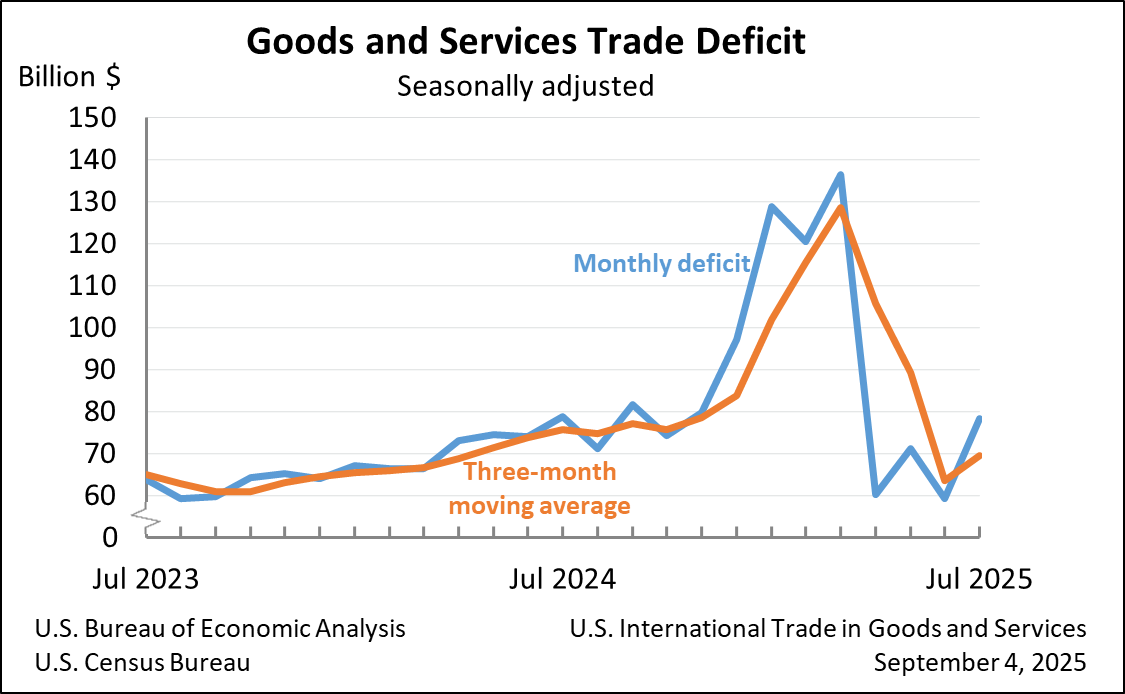Bureau of Economic Analysis
U.S. International Trade in Goods and Services, July 2025
The U.S. goods and services trade deficit increased in July 2025 according to the U.S. Bureau of Economic Analysis and the U.S. Census Bureau. The deficit increased from $59.1 billion in June (revised) to $78.3 billion in July, as imports increased more than exports. The goods deficit increased $18.2 billion in July to $103.9 billion. The services surplus decreased $1.1 billion in July to $25.6 billion.
Principal Federal Economic Indicators
Noteworthy
The Latest
Outdoor Recreation Satellite Account, U.S. and States, 2019
The new U.S. data show that the outdoor recreation economy accounted for 2.1 percent ($459.8 billion) of current-dollar gross domestic product (GDP) for the nation in 2019. At the state level, outdoor recreation value added as a share of state GDP ranged from 5.8 percent in Hawaii to 1.3 percent in Connecticut. The share was 1.1 percent in the District of Columbia.
Outdoor Recreation Satellite Account, U.S. and States, 2019
The new U.S. data show that the outdoor recreation economy accounted for 2.1 percent ($459.8 billion) of current-dollar gross domestic product (GDP) for the nation in 2019. At the state level, outdoor recreation value added as a share of state GDP ranged from 5.8 percent in Hawaii to 1.3 percent in Connecticut. The share was 1.1 percent in the District of Columbia.
September 2020 Trade Gap is $63.9 Billion
The U.S. monthly international trade deficit decreased in September 2020 according to the U.S. Bureau of Economic Analysis and the U.S. Census Bureau. The deficit decreased from $67.0 billion in August (revised) to $63.9 billion in September, as exports increased more than imports. The previously published August deficit was $67.1 billion. The goods deficit decreased $3.1 billion in September to $80.7 billion. The services surplus increased…
U.S. International Trade in Goods and Services, September 2020
The U.S. monthly international trade deficit decreased in September 2020 according to the U.S. Bureau of Economic Analysis and the U.S. Census Bureau. The deficit decreased from $67.0 billion in August (revised) to $63.9 billion in September, as exports increased more than imports. The previously published August deficit was $67.1 billion. The goods deficit decreased $3.1 billion in September to $80.7 billion. The services surplus increased less…
Personal Income and Outlays, September 2020
Personal income increased 0.9 percent while consumer spending increased 1.4 percent in September, according to estimates released today by the Bureau of Economic Analysis.
Personal Income and Outlays, September 2020
Personal income increased 0.9 percent while consumer spending increased 1.4 percent in September, according to estimates released today by the Bureau of Economic Analysis.
Gross Domestic Product, Third Quarter 2020 (Advance Estimate)
Real gross domestic product (GDP) increased at an annual rate of 33.1 percent in the third quarter of 2020, as efforts continued to reopen businesses and resume activities that were postponed or restricted due to COVID-19. In the second quarter of 2020, real GDP decreased 31.4 percent. For more details, including source data, see the Technical Note.
Gross Domestic Product, Third Quarter 2020 (Advance Estimate)
Real gross domestic product (GDP) increased at an annual rate of 33.1 percent in the third quarter of 2020, as efforts continued to reopen businesses and resume activities that were postponed or restricted due to COVID-19. In the second quarter of 2020, real GDP decreased 31.4 percent.
2021 Calendar Features Advances in State Data
Want to stay on top of what’s happening with state economies? BEA’s 2021 calendar has some new dates to circle. Next year our key state economic measure will be published earlier each quarter. And we’ll introduce inflation-adjusted consumer spending statistics for every state.
Personal Consumption Expenditures by State, 2019
State personal consumption expenditures (PCE) increased 3.9 percent in 2019, a deceleration from the 4.9 percent increase in 2018. The percent change in PCE across all states ranged from 5.7 percent in Utah to 1.8 percent in Vermont.




